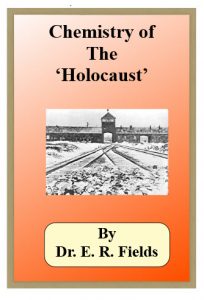It has escaped the notice of most people that stories of a “Nazi Holocaust” during World War II are actually impossible as regards the chemistry of poisons. This can be verified by calling or writing the American Cyanamid Co., Box 31, Linden, NJ 07036, telephone (201) 862-6000, or by consulting standard reference works such as the various editions (in particular the 11th) of the Encyclopaedia Britannica under “Hydrocyanic Acid,” “’Prussic Acid,” “Poisons,” Gleason’s Clinical Toxicology of Commercial Products, or Legal Medicine and Toxicology by Peterson, Haines and Webster (2nd edition).
One might be permitted to ask:
1) whether there is any such thing as an “amethyst-blue crystal of hydrogen cyanide” (Reitlinger, The Final Solution, p. 160; Shirer, Rise and Fall of the Third Reich, p. 970);
2) whether hydrogen cyanide can be solidified at room temperature in an ordinary tin can (Hilberg, The Destruction of the European Jews, p. 566, “The hydrogen cyanide, solidified into pellets, immediately passed into the gaseous state.”);
3) whether hydrogen cyanide can be made to crystallize in a vacuum and become gaseous upon exposure to air (“I used Zyklon B, which was a crystallized prussic acid,” Rudolf Hoess at Nuremberg, quoted in Shirer, p. 968);
